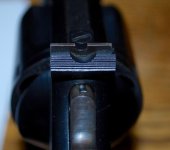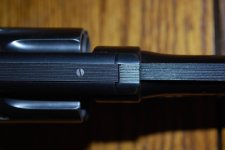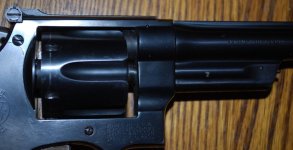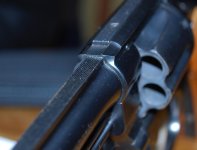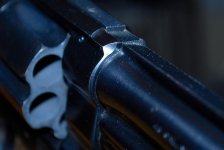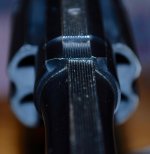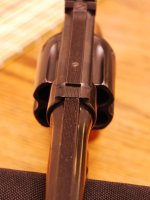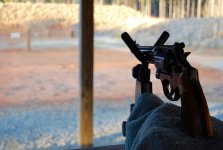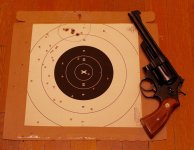Hi,
I just picked up this nice 1950 Target, and noticed that the rear sight needed to be adjusted far left to get it zeroed. (see pic #1)
Later, I noticed that the reason for this is that the barrel is indexed past the 12 O'Clock position. (see pic #2) The barrel rib can be clearly seen as not being aligned with the topstrap. To go along with this, the front sight is slightly canted off center. Also the ejector doesn't quite fit with the locking stud in the barrel shroud.
So, what's the fix? Can the barrel be backed off slightly (given that the work would be done by a competent person having the right tools), or does the barrel need to be completely reset?
Kuhnhausen and a couple others suggest the latter.
I suppose if it's the latter case, it's the whole ball of wax: resetting the shoulder, possibly cutting one more turn of thread, facing off the barrel breech, and recutting the forcing cone.....?
Thanks for any advice,
Jim
PS: See post #14 for update
I just picked up this nice 1950 Target, and noticed that the rear sight needed to be adjusted far left to get it zeroed. (see pic #1)
Later, I noticed that the reason for this is that the barrel is indexed past the 12 O'Clock position. (see pic #2) The barrel rib can be clearly seen as not being aligned with the topstrap. To go along with this, the front sight is slightly canted off center. Also the ejector doesn't quite fit with the locking stud in the barrel shroud.
So, what's the fix? Can the barrel be backed off slightly (given that the work would be done by a competent person having the right tools), or does the barrel need to be completely reset?
Kuhnhausen and a couple others suggest the latter.
I suppose if it's the latter case, it's the whole ball of wax: resetting the shoulder, possibly cutting one more turn of thread, facing off the barrel breech, and recutting the forcing cone.....?
Thanks for any advice,
Jim
PS: See post #14 for update
Attachments
Last edited:

